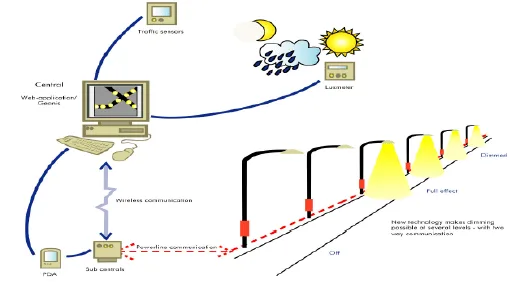Street lights play a vital role in urban infrastructure, ensuring safety, security, and visibility in our cities. However, managing these lights efficiently is a challenge for municipal authorities worldwide. Traditional maintenance approaches often involve reactive responses to failures, leading to downtime, increased costs, and public inconvenience. But what if we could predict when a street light might fail before it happens? Welcome to the era of predictive maintenance in street light control.
In this article, we delve into the concept of predictive maintenance for street lights, exploring its benefits, technological advancements, and the potential it holds for creating smarter, more sustainable cities.
Understanding Predictive Maintenance:
Predictive maintenance involves using data analytics, machine learning algorithms, and IoT (Internet of Things) sensors to predict equipment failures before they occur. By analyzing historical data and real-time information, predictive maintenance systems can identify patterns and anomalies indicative of potential issues. This proactive approach enables timely interventions, reducing downtime, optimizing resources, and extending the lifespan of assets.
Applying Predictive Maintenance to Street Light Control:
The application of predictive maintenance in street light control involves equipping light poles with various sensors and IoT devices. These sensors collect data on factors such as light intensity, temperature, power consumption, and environmental conditions. By analyzing this data, predictive maintenance algorithms can detect abnormalities that may signal impending failures, such as a decrease in light output or irregular power consumption.
Benefits of Predictive Maintenance for Street Lights:
Cost Savings: Predictive maintenance helps municipalities reduce operational costs by minimizing emergency repairs and optimizing maintenance schedules. By addressing issues proactively, authorities can avoid costly downtime and extend the lifespan of street lights, resulting in significant long-term savings.
Enhanced Safety: Timely maintenance of street lights ensures consistent illumination, improving visibility and safety for pedestrians, cyclists, and motorists. By preventing sudden outages or dimming, predictive maintenance contributes to reducing accidents and crime rates in urban areas.
Energy Efficiency: Predictive maintenance can identify inefficiencies in street light operations, such as malfunctioning components or unnecessary energy consumption. By addressing these issues promptly, municipalities can optimize energy usage, lower electricity bills, and reduce their carbon footprint, contributing to environmental sustainability.
Improved Citizen Experience: Reliable street lighting enhances the overall quality of life for residents, fostering a sense of security and well-being. Predictive maintenance minimizes disruptions and inconvenience caused by faulty street lights, leading to higher satisfaction levels among citizens.
Technological Advancements Driving Predictive Maintenance:
IoT Integration: The proliferation of IoT technology enables seamless integration of sensors and devices into street light infrastructure, facilitating real-time data collection and analysis.
Machine Learning Algorithms: Advanced machine learning algorithms can analyze vast amounts of data to identify complex patterns and predict potential failures with high accuracy.
Remote Monitoring Systems: Remote monitoring systems allow authorities to monitor street light performance from a centralized dashboard, enabling proactive maintenance interventions and efficient resource allocation.
Predictive Analytics Platforms: Dedicated predictive analytics platforms offer comprehensive tools for data processing, visualization, and predictive modeling, empowering municipalities to make data-driven decisions in street light management.
Case Studies:
Los Angeles, USA: The city of Los Angeles implemented a predictive maintenance system for its street lights, resulting in a 30% reduction in maintenance costs and a significant decrease in outage-related complaints from residents.
Barcelona, Spain: Barcelona deployed IoT sensors on its street lights to monitor environmental conditions and detect potential failures. This proactive approach helped the city save millions of euros in maintenance expenses while improving the reliability of its lighting infrastructure.
Challenges and Considerations:
Data Privacy and Security: Collecting and analyzing data from street light sensors raises concerns about data privacy and security. Municipalities must implement robust measures to protect sensitive information and ensure compliance with relevant regulations.
Integration with Existing Infrastructure: Integrating predictive maintenance systems with legacy street light infrastructure can be challenging and may require substantial investments in retrofitting and upgrades.
Technical Expertise: Implementing and managing predictive maintenance systems requires specialized technical expertise in data analytics, machine learning, and IoT technology, which may pose a barrier for some municipalities.
Conclusion:
Predictive maintenance represents a paradigm shift in street light control, offering municipalities the ability to proactively manage their lighting infrastructure and enhance the efficiency, safety, and sustainability of urban environments. By harnessing the power of data analytics, machine learning, and IoT technology, cities can illuminate the path towards a brighter, smarter future.
As we embrace the next generation of street light control through predictive maintenance, let us illuminate not only our streets but also the possibilities for creating more resilient, livable, and inclusive cities for generations to come.


More Stories
Load Cell for Packaging Industries – MODEL: HSSB, BBM, SESB
10 Proven Ways to Earn Money as a Coach in 2025
Low-Interest Collateral Loans on Rare Coins in Peachtree City